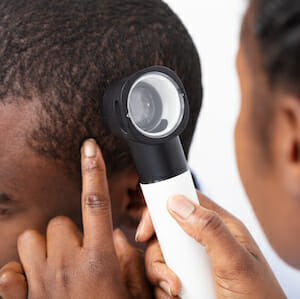Do Black People Get Skin Cancer?
- Posted on: May 16 2022

Do Black People Get Skin Cancer?
It’s a myth that Black people and other people of color can’t get skin cancer. This potentially deadly disease can affect anyone, including people with black and brown skin. Exposure to ultraviolet rays from the sun increases the risk of skin cancer for everyone, although people who have black or brown skin don’t get skin cancer as frequently as people with fair skin tones.
Darker skin tones contain higher amounts of melanin, which is the pigment that gives your skin its color. Higher amounts of melanin absorb harmful ultraviolet rays from the sun and protect cells from sun damage. Light-colored skin lacks this protection from the sun, increasing the risk of sun damage.
Although melanin offers some sun protection, it’s not enough to completely protect brown and black skin from the threat of skin cancer. Wearing a broad-spectrum sunscreen with SPF 30 or higher is essential for all skin tones.
What Are the Symptoms of Skin Cancer?
A noticeable change in the appearance of your skin is a common symptom of skin cancer. This includes a change in an existing mole or the development of a new growth on the skin. Cancerous spots are different in color compared to the surrounding skin. For people of color, cancerous spots often appear purple, dark brown, black, or ashen gray.
What Are the Risks of Skin Cancer in People of Color?
People of color are more likely to die from skin cancer. They may not seek medical care for a suspicious mole because of the common misperception that dark-skinned people aren’t at risk of skin cancer. This creates a dangerous situation in which people of color are diagnosed with skin cancer at a later stage. Skin cancer is much harder to treat when it reaches an advanced stage.
How Is Skin Cancer Treated?
Skin cancer treatment depends on a variety of factors, including the type of cancer you have, where it’s found on your body, and its stage. Treatment options for skin cancer include:
Excision
Your dermatologist uses a small blade to cut away and remove the cancerous growth and a small portion of the surrounding skin.
Scraping and Burning
The layers of cancerous skin cells are scraped away and cauterized with an electric needle to destroy all cancer cells.
Photodynamic Therapy
During a photodynamic therapy treatment, a chemical agent that reacts to laser light is applied to cancerous cells. Treatment selectively destroys any cancerous cells while leaving the surrounding tissue relatively unharmed.
Cryotherapy
This treatment option uses liquid nitrogen to freeze and destroy cancerous tissue. After treatment, the dead cells gradually slough off.
Mohs surgery
Mohs surgery has the highest success rate of all types of skin cancer treatment. It’s regarded for its effectiveness in treating basal cell and squamous cell skin cancer, which are the two most common forms. During Mohs surgery, your surgeon removes skin cancer layer by layer. Each layer of skin is examined under a microscope until no cancerous cells remain.
How to Check Your Skin for Skin Cancer
Detecting skin cancer early is crucial to successful treatment. We recommend performing a thorough skin exam once a month to help you become familiar with the spots or moles present on your body. This makes it easier for you to identify anything abnormal, helping you detect the early signs of skin cancer.
To perform a skin self-exam, you’ll examine your entire body from head to toe. Pay special attention to places on your body that don’t get a lot of sun exposure: lower legs, groin, the bottoms of feet, palms, and under the nails. When Black people have melanoma, the most dangerous type of skin cancer, it usually affects these areas of the body. You should also carefully examine the inside of your mouth, scalp, and neck.
If you have skin of color, you’ll want to pay close attention to these symptoms when examining your skin:
- A patch of skin or a spot that is darker than the surrounding area
- A spot or mole that has an irregular border or an asymmetrical shape
- A spot or growth that bleeds
- A sore that heals and comes back
- A sore that doesn’t heal
- A patch of skin that feels scaly, rough, or dry
- Any spot on your skin that gets larger or changes in any way
- Changes in the color of a nail or a dark line or streak around a nail
Schedule Your Annual Skin Exam at Asarch Dermatology
Make an appointment at Asarch Dermatology if you have any concerns about a spot on your skin. In addition to performing a monthly skin exam at home, we also recommend scheduling an annual skin exam with a member of our experienced team of skin care experts.
Posted in: Blog Post, Mohs Surgery, Skin Cancer
